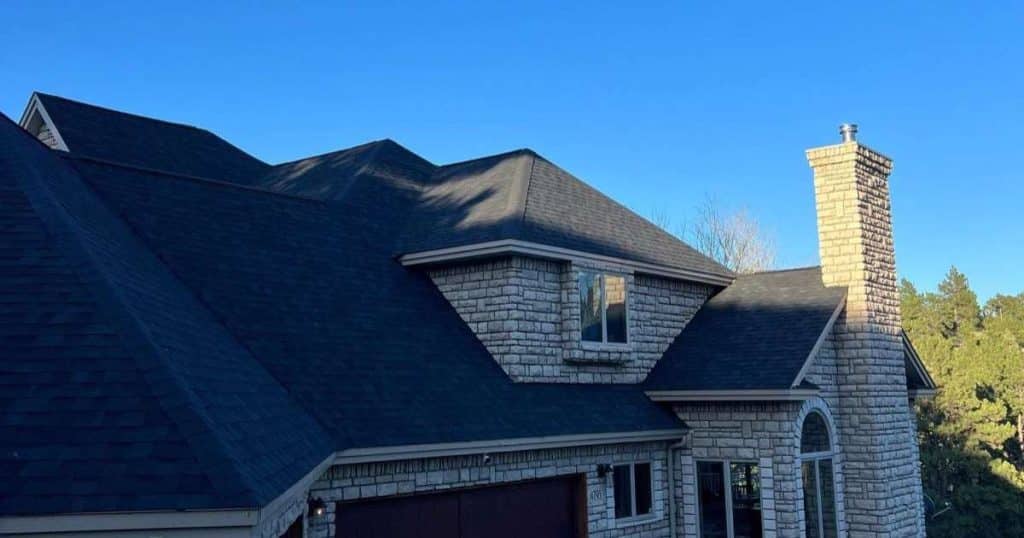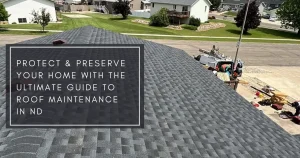The harsh weather conditions in North Dakota, especially in Bismarck and Williston, can wreak havoc on your roof, leading to costly repairs and even premature replacement.
With the fluctuating temperatures, heavy snowfalls, and strong winds, your roof is constantly exposed to potential damage. Ignoring regular maintenance can shorten your roof’s lifespan, leading to significant financial burdens.
Regular roof maintenance, guided by a well-structured roof maintenance checklist, can help you protect your investment, ensuring your roof stays in top condition despite North Dakota’s challenging climate.
Why Roof Maintenance is Crucial in North Dakota
Living in Bismarck or Williston, North Dakota, means dealing with extreme weather conditions that can take a toll on your roof. From blistering summer heat to freezing winter temperatures, your roof endures a lot.
Regular roof maintenance not only helps in preventing leaks and damage but also extends the overall lifespan of your roof. With proper care and a consistent roof maintenance program, you can avoid expensive repairs and keep your home safe.
Roof Maintenance Checklist
A roof maintenance checklist is your best friend when it comes to keeping your roof in optimal condition. Here’s a comprehensive checklist to guide you:
1. Visual Inspection
- Look for Missing, Damaged, or Curling Shingles:
Regularly inspect your roof for any shingles that are cracked, missing, or curling at the edges. These are common signs of wear and tear, particularly in regions like Bismarck and Williston, ND, where the weather can be extreme. Damaged shingles can lead to leaks, which can cause significant interior damage if not addressed promptly.
- Check for Signs of Water Damage or Leaks Inside Your Home:
After inspecting the exterior, don’t forget to check your home’s interior for any signs of water damage, such as stains on ceilings or walls. Leaks can often go unnoticed until they cause substantial damage, so regular inspections are crucial
- Inspect the Flashing Around Chimneys, Vents, and Skylights:
Flashing is the material that seals the edges of your roof’s protrusions, such as chimneys, vents, and skylights. Over time, flashing can deteriorate, leading to leaks. Ensure the flashing is securely in place and free of rust or damage.
- Examine the Gutters for Debris and Ensure They’re Securely Attached:
Gutters play a vital role in directing water away from your home. Check that they are free from debris like leaves and twigs, and make sure they are securely attached to your roof. Loose or clogged gutters can lead to water pooling on your roof, increasing the risk of leaks.
2. Clear Debris
- Remove Leaves, Twigs, and Other Debris from Your Roof and Gutters:
Debris accumulation on your roof and in your gutters can trap moisture, leading to roof damage and mold growth. Regularly clearing this debris is essential to maintaining a healthy roof.
- Trim Overhanging Branches That Could Damage Shingles or Block Gutters:
Overhanging branches can scrape and damage shingles, and they often drop leaves and twigs that can clog gutters. Trim these branches back to prevent potential damage and maintain proper water drainage.
3. Check Attic Ventilation
- Ensure That Your Attic Is Well-Ventilated to Prevent Moisture Buildup:
Proper attic ventilation is crucial to maintaining a healthy roof. Without adequate ventilation, moisture can build up in your attic, leading to mold growth and damage to your roof structure. Ensure vents are not blocked and that air can circulate freely.
- Look for Signs of Mold or Mildew, Which Can Indicate Poor Ventilation:
Mold and mildew are clear indicators of moisture problems. If you notice these in your attic, it may be a sign that your ventilation needs improvement. Addressing this issue quickly can prevent more significant problems down the line.
4. Examine Roof Penetrations
- Inspect Areas Where Pipes, Vents, and Chimneys Penetrate the Roof:
Any place where an object penetrates your roof is a potential weak spot. Carefully inspect these areas for cracks, gaps, or wear. Pay close attention to the seals around these penetrations, as they are vital in preventing leaks.
- Ensure Seals Are Intact and No Gaps Are Present:
The seals around your roof’s penetrations should be tight and in good condition. If you find any gaps or deteriorating seals, they should be repaired immediately to prevent water infiltration.
5. Inspect and Clean Gutters
- Clean Out Gutters to Prevent Water Backup and Potential Roof Damage:
Clogged gutters can cause water to back up under your roof’s edge, leading to rot and leaks. Regularly clean your gutters to ensure they are directing water away from your home properly.
- Check for Sagging or Damaged Sections That Might Need Repair:
Gutters should be straight and secure. If you notice any sagging or damaged sections, they may need to be repaired or replaced to ensure proper water flow.
6. Check the Roof for Moss and Algae
- Remove Any Moss or Algae Growth to Prevent Shingle Deterioration:
Moss and algae can retain moisture against your roof, leading to shingle deterioration and other issues. Carefully remove any growth using a soft-bristle brush and consider applying a moss control product to prevent future growth.
- Consider Applying a Moss Control Product if Growth Is Significant:
In areas prone to moss and algae, such as the damp regions of North Dakota, applying a moss control product can help keep your roof clean and extend its lifespan.
7. Schedule Professional Inspections
- Have a Professional Roofing Contractor Inspect Your Roof at Least Once a Year:
Even if you regularly inspect your roof yourself, it’s wise to have a professional roofing contractor conduct a thorough inspection annually. They can identify issues that you might miss and provide expert advice on maintaining your roof.
- Consider a Roof Maintenance Program to Keep Your Roof in Top Shape:
Many roofing companies offer maintenance programs that include regular inspections, cleaning, and minor repairs. Enrolling in such a program can give you peace of mind knowing your roof is being well-maintained by professionals.
By following this detailed roof maintenance checklist, homeowners in Bismarck and Williston, ND, can ensure their roofs remain in excellent condition year-round. Regular maintenance not only prolongs the life of your roof but also helps avoid costly repairs and protects your home from the elements.
Roof Maintenance Tips for Homeowners in Bismarck and Williston, ND

Taking proactive steps to maintain your roof can save you from costly repairs down the road. Here are some essential roof maintenance tips for homeowners in Bismarck and Williston, North Dakota:
- Regular Roof Inspections
Regular roof inspections help identify potential issues before they become major problems. Conduct an inspection after every major storm to check for damage. Look for cracked or missing shingles, damaged flashing, and signs of water intrusion.
- Seasonal Roof Care
Different seasons require different roof care tips. In the summer, keep your roof clean and free from debris to prevent heat buildup. During winter, clear snow and ice from your roof to avoid ice dams, which can cause leaks.
- Shingle Roof Maintenance
For homes with shingle roofs, it’s important to regularly check for any loose or damaged shingles. Replace them immediately to prevent leaks and further damage.
- Invest in Quality Materials
Investing in high-quality roofing materials during repairs can enhance your roof’s durability and resistance to North Dakota’s extreme weather.
- Roof Care Tips for Winter
In winter, ensure your attic is well-insulated to prevent ice dams. Regularly clear snow from your roof to avoid excess weight and potential collapse.
- Maintain Roof Accessories
Check your roof’s accessories, such as vents, skylights, and chimneys, for any damage. Ensure they are properly sealed to prevent water from entering your home.
Home Roof Maintenance: When and How Often?
Consistency is key when it comes to roof maintenance. Regular roof maintenance should be conducted twice a year, ideally in the spring and fall. This timing allows you to prepare your roof for the harsh winter months and repair any damage sustained during the summer. Additionally, inspect your roof after major storms, as extreme weather can cause immediate damage that needs prompt attention.
FAQs
What is roof maintenance?
Roof maintenance involves regular inspections, cleaning, and repairs to keep your roof in good condition, prevent leaks, and extend its lifespan.
What maintenance should be done on a roof?
Regular maintenance includes inspecting shingles, clearing debris, checking flashing, cleaning gutters, and ensuring proper attic ventilation.
How to clean and maintain your roof?
Clean your roof by removing debris, moss, and algae. Use a garden hose to wash the roof, but avoid pressure washing as it can damage shingles.
How to keep a roof in good condition?
Regularly inspect your roof, make necessary repairs promptly, keep gutters clean, and ensure proper ventilation to prevent moisture buildup.
What time of year is best for roof repairs?
Spring and fall are the best times for roof repairs. The weather is mild, making it easier to work on the roof, and you can prepare your roof for extreme winter conditions.
What are some helpful tips for roof maintenance this summer?
In summer, keep your roof clean, remove overhanging branches, and ensure your attic is well-ventilated to prevent heat buildup and damage to the shingles.
How often should roof maintenance be done?
Roof maintenance should be done twice a year, in the spring and fall, with additional inspections after major storms.
How do I choose a roofer?
Choose a roofer based on their experience, reputation, and certifications. Check for local references and ensure they have the necessary licenses and insurance.
How often should I clean my roof?
Clean your roof at least once a year to remove debris, moss, and algae. More frequent cleaning may be necessary if you live in an area with heavy tree cover.
When to replace roof?
Replace your roof if it’s over 20 years old, has widespread damage, or if you notice persistent leaks and structural issues.
Conclusion
Regular roof maintenance is essential for homeowners in Bismarck and Williston, North Dakota, to ensure their roofs can withstand the region’s harsh weather. By following a comprehensive roof maintenance checklist and implementing these roof care tips, you can extend your roof’s lifespan, avoid costly repairs, and keep your home safe and secure. Don’t forget to schedule regular inspections and consider enrolling in a roof maintenance program for professional assistance.
If you’re looking for more information on roofing costs or need guidance on maintaining your roof, feel free to check out our detailed guide on roofing labor costs for Montana, Iowa, ND, and SD.
For detailed information on roofing costs, you can refer to our previous blog on Roofing Labor Cost Per Square: A Comprehensive Guide for Montana, Iowa, ND & SD.



